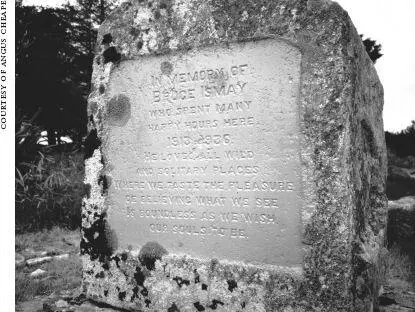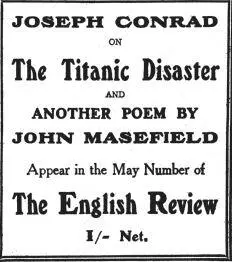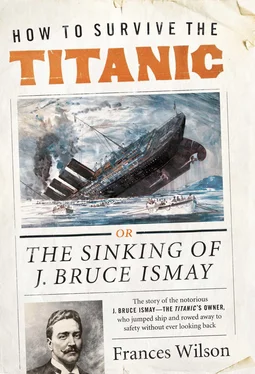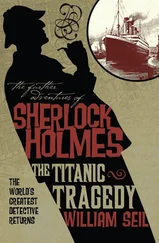The crew listen to Karain’s tale in silence and try to console him: ‘Every one of us, you’ll admit, has been haunted by some woman,’ they say. To protect the chief from the whispering shade of his murdered friend, they give him a talisman in the form of a coin depicting the head of Queen Victoria. It is unclear whether they are helping him to face or to shirk his crime, but Karain, the narrator concludes, ‘had known remorse and power, and no man can demand more from life’.
Marian Thayer, the woman who constantly occupied Ismay’s thoughts and to whom he had talked ‘all the time’ in the year following the wreck, died on 14 April 1944. It was exactly thirty-two years to the day after the death of her husband on the Titanic. The curious timing of Mrs Thayer’s death recalls the lines by Louis MacNeice on the death of his grandmother. As a boy in Belfast, MacNeice had ‘one shining glimpse of a boat so big it was named Titanic’:
As now for this old tired lady who sails
Toward her own iceberg calm and slow;
We hardly hear the screws, we hardly
Can think her back her four score years.
…the day went down
To the sea in a ship, it was grey April,
The daffodils in her garden waited
To make her a wreath, the iceberg waited;
At eight in the evening the ship went down.
Marian Thayer never remarried and nor did she remove from her dressing table the framed verses Ismay had sent her in 1913. Jack Thayer waited until 1940 to add his own version of events to the sea of survivors’ stories. ‘No two happenings in the stream of space time are identical,’ The Sinking of the SS Titanic begins, and ‘no two individuals no matter how close they may be together on shipboard have the same description of experience to relate’. For Thayer as for Ismay, Lightoller and many others, the Titanic was a tale of sleeping and waking, but with the hindsight of twenty-eight years and two world wars, his perspective had changed. It was not only himself who woke to the sound of a nail scraping along the side of the ship. ‘To my mind the world of today awoke April 15th, 1912.’ 12
The world went back to sleep again as far as the Titanic was concerned, but interest was reawakened in 1955 by Walter Lord’s non-fiction novel, A Night to Remember, which two years later was filmed at the Pinewood Studios in Elstree, one mile from the school where Ismay had been so unhappy and Conrad, as a guest of the riotous Sanderson family, had been so happy. Kenneth More played a splendidly game Lightoller, the hero of the drama, and Ismay was portrayed by Frank Lawton as a fool in a pair of striped pyjamas. Lightoller would never see himself immortalised; he died of heart failure in 1952, without getting his own command in the White Star Line or ever receiving from the company ‘a word of thanks’ for taking on the role of ‘whipping boy’ at the inquiries. ‘It must’, he concluded, ‘have been a very curious psychology that governed the managers of that magnificent line.’ 13The very brave can be very dangerous and, according to Walter Lord, Lightoller was ‘too much the romantic individualist, too likely to say what he thought… It was fatal for a White Star Line officer to have been associated with the Titanic.’ 14
In 1935, Lightoller had written his memoirs, Titanic and Other Ships, which he dedicated to Sylvia, ‘My persistent wife, who made me do it’. Here he proves himself a man of many-sided courage, an adventurer addicted to the unpredictability of sea life, to the ‘feel of something living under my feet’. It is a tale of cyclones, shipwrecks and desert islands, of albatross bones, giant sea bats, and sailing ships with ‘towering tiers of bellying canvas’. It is not until chapter thirty that Lightoller arrives at the maiden voyage of the Titanic, but he does not repeat here his claim that following the collision Ismay had ordered the Captain to go ‘Slow Ahead’ or that Robert Hichens had turned the wheel the wrong way. A storyteller with several versions of the night, each one tailored to a specific audience, the story told by Lightoller to his adoring wife must be regarded in the same light as the many other accounts by survivors of their experience. It is a version of events, to be placed on top of other versions much as the Victorian geneticist, Francis Galton, overlapped photographs of faces so that the individual features vanished and the common characteristics were accentuated. Lightoller’s role as Ismay’s secret sharer was saved for Sylvia’s ears alone, and after her husband’s death she carried the story around like a loaded gun. In a letter to Walter Lord sent from America in 1956, Sylvia Lightoller revealed that she was hoping to ‘get a call from the CBS for their “I’ve Got a Secret” TV programme as I have rather a good one about the Titanic, so if by chance I am chosen to go to New York I should so much like to meet you and have a chat’. Neither CBS nor Walter Lord took up her offer. 15
Florence Ismay was not amongst those who wrote to Walter Lord with her account of what ‘really happened’. The Titanic had ruined the first part of her life and she was determined to enjoy the second, which began after Ismay died, at which point she surrendered her British citizenship and took an oath of repatriation with the United States. This old tired lady was ninety-six when her own ship went down on New Year’s Eve 1963, between the end of the Chatterley ban and the Beatles’ first LP
‘It is easy to jump in,’ J. Bruce Ismay had told Harold Sanderson in 1904, ‘but it would be difficult, if not impossible, to climb out.’ Ismay never climbed out from the hole into which he had fallen and nor did he achieve the catharsis that traditionally comes with tragedy, but when we see him through Conrad’s hooded eyes he has something of the tragic hero. His destiny lay submerged, riding in wait, ready to leap. He was an ordinary man caught in extraordinary circumstances, who behaved in a way which only confirmed his ordinariness. Ismay is the figure we all fear we might be. He is one of us.

Memorial stone in the garden of Costelloe Lodge

Advertisement for Joseph Conrad’s first essay on the Titanic (Daily Sketch, 3 May 1912)
What solitary icebergs we are…
Virginia Woolf,
The Voyage Out
In August 1924, one year after returning from New York on board the Majestic — his single experience of travelling on a White Star liner — Conrad, the most remarkable of Ismay’s secret sharers, died of a heart attack. ‘Suddenly,’ wrote Virginia Woolf, ‘without giving us time to arrange our thoughts or prepare our phrases, our guest has left us; and his withdrawal without farewell or ceremony is in keeping with his mysterious arrival, long years ago, to take up his lodging in this country.’
Conrad produced more words on the Titanic than any of his literary contemporaries. Even the press expressed surprise at the silence of the writing community in response to the greatest peacetime shipwreck in history. ‘Few of the magazines this month have anything to say regarding the terrible disaster in the North Atlantic which has shocked and saddened the whole world,’ noted the Daily Telegraph in the summer of 1912 in its round-up of journals such as Blackwood’s, Cornhill and Strand. It is only ‘Mr Joseph Conrad in the English Review’, who ‘makes some comments on the catastrophe’. W. B. Yeats, the national poet of the country in which the Titanic was built, said nothing in public about the event at all; Henry James, who had made the same crossing between England and his native New York on a dozen occasions, mentions the Titanic only once, in a condolence letter to friends of the American artist Francis Millet, who was travelling with White House aide Archie Butt. E. M. Forster, despite his sense in Howards End that ‘any fate was titanic’, remained silent, as did D. H. Lawrence. John Galsworthy attended the inquiry in Washington but apart from comments confided to his diary, he wrote nothing about the experience, not even reporting his impressions to Conrad.
Читать дальше














